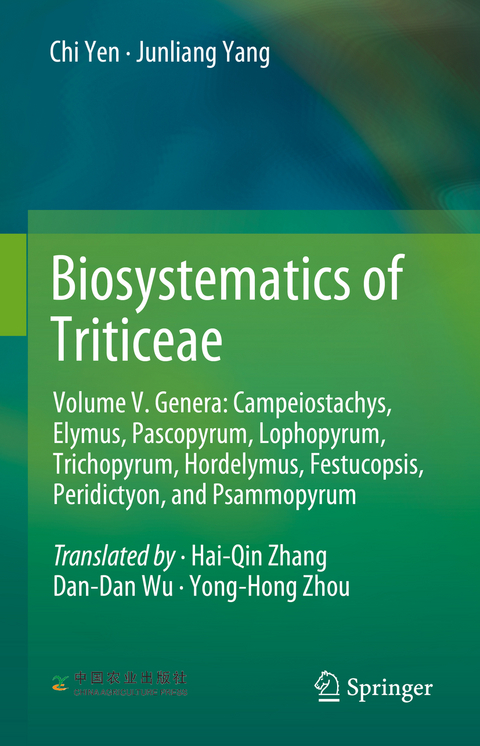
Biosystematics of Triticeae
Springer Verlag, Singapore
978-981-19-0014-3 (ISBN)
This book review and rearrange the research data of Triticeae published over hundreds of years, applying a modern scientific approach. Triticeae is an important tribe in the grass family (Peaceae). It includes the major cereal crops, such as wheat, barley and rye, in addition to many valuable forage crops found in different genera, such as Elymus, Agropyron, Pasthyrostachys, and Leymus. The knowledge of appropriate Triticeae taxonomy and biosystematics will serve as genetic breeding of wheat, barley, rye and forage grass. The authors attempted to remain the truth and remove the false for deriving a more natural biosystematics of Triticeae.
This book covers taxonomy, cytogenetics, and molecular phylogeny. It summarizes the biosystematics of Triticeae with comprehensive and updated data. This book is divided into five volumes (Volumes 1- 5), and includes 30 genera, 2 subgenera, 464 species, 9 subspecies, and 186 varieties in Triticeae. Volume 5 introduces nine perennial genera in Triticeae: Campeiostachys, Elymus, Pascopyrum, Lophopyrum, Trichopyrum, Hordelymus, Festucopsis, Peridictyon, and Psammopyrum.
Elymus (StH), Campeiostachys (StYH), Lophopyrum (E), and Trichopyrum (ESt)are polymorphic genus. They show similar morphological characters, and it is difficult to distinguish them based merely on morphological variation. Pascopyrum (StHNsXm), Hordelymus (XoXr), Festucopsis (L), Peridictyon (Xp), and Psammopyrum (EL) are small genera, mostly monotypic genera.
This book can serve as highly qualified, valuable, and convenient handbooks for audiences who are interested in Triticeae. This book also includes many illustrations, in addition to the description, to help the audience understand, morphological features of the concerned taxa, which makes the explanation more precise andobvious. It is a useful tool to understand the relationship among species in Triticeae.
Hai-Qin Zhang, Yong-Hong Zhou, and Dan-Dan Wu focus on studies of biosystematics of Triticeae, especially for the perennial Triticeae species. They have carried out extensive research into the perennial Triticeae species, including clarifying the genomic constitutions of species, the phylogeny of Triticeae species, and their breeding utilization.
Chapter 1. Biosystematics of Genus Campeiostachys.- Chapter 2. Biosystematics of Genus Elymus.- Chapter 3. Biosystematics of Genus Pascopyrum.- Chapter 4. Biosystematics of Genus Lophopyrum.- Chapter 5. Biosystems of Genus Trichopyrum.- Chapter 6. Biosystematics of genus Hordelymus.- Chapter 7. Biosystematics of Genus Festucopsis.- Chapter 8. Biosystematics of Genus Peridictyon.- Chapter 9. Biosystematics of Genus Psammopyrum.-
| Erscheinungsdatum | 25.08.2022 |
|---|---|
| Übersetzer | Hai-Qin Zhang, Dan-Dan Wu, Yong-Hong Zhou |
| Zusatzinfo | 1 Illustrations, black and white; XVII, 712 p. 1 illus. |
| Verlagsort | Singapore |
| Sprache | englisch |
| Maße | 155 x 235 mm |
| Themenwelt | Naturwissenschaften ► Biologie ► Botanik |
| Naturwissenschaften ► Biologie ► Evolution | |
| Weitere Fachgebiete ► Land- / Forstwirtschaft / Fischerei | |
| Schlagworte | Biosystematics • classification • Evolution • Taxonomy • triticeae |
| ISBN-10 | 981-19-0014-0 / 9811900140 |
| ISBN-13 | 978-981-19-0014-3 / 9789811900143 |
| Zustand | Neuware |
| Informationen gemäß Produktsicherheitsverordnung (GPSR) | |
| Haben Sie eine Frage zum Produkt? |
aus dem Bereich


